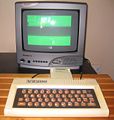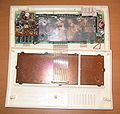VTech Laser 200
 The VTech Laser 200, rebadged as a Dick Smith VZ200 | |
| Manufacturer | Video Technology |
|---|---|
| Type | Personal Computer |
| Release date | November 1983[1] |
| Introductory price | $99USD £98GBP |
| Discontinued | 1985 |
| Units sold | 200,000 in Australia |
| Media | Cassette tape Disk drive |
| Operating system | BASIC V1.2 |
| CPU | Zilog Z80A clocked at 3.58MHz, Motorola 6847 video processor |
| Memory | 6-22KB USER-RAM + 2KB VRAM, 16KB ROM |
| Display | 32×16 (8 colors), 128×64 (4 colors) |
| Input | 45 key Keyboard |
| Power | 9 volt |
| Dimensions | 29 × 17 × 4cm |
| Mass | 800g |
| Predecessor | VTech Laser 110 |
| Successor | VTech Laser 310 |

The VTech Laser 200 was an early 8-bit home computer from 1983, also sold as the Salora Fellow (mainly in Scandinavia, particularly Finland), the Texet TX8000 (in the United Kingdom) and the Dick Smith VZ 200 (in Australia and New Zealand).
The machine ran basic games on cassette such as "Hoppy" Frogger, "Cosmic Rescue" Scramble, "VZ Invaders" Space Invaders and Moon Patrol. The computer was discontinued in 1985 to make way for more advanced home computers.
Release
At its UK launch, Texet claimed that the £98 TX8000-branded version was the cheapest colour home microcomputer on the market. However, this was not enough to ensure its success against the dominant ZX Spectrum and similar machines already on sale.[2] Most notably, the Spectrum-like Oric 1 was selling for £99 at this point, and offered a far higher specification than the Texet for little difference in cost.
The "Dick Smith"-badged VZ 200 was more successful in Australia, where it proved popular as a first computer.[3]
An improved version known as the VTech Laser 310, or the Dick Smith VZ 300 was released in 1985 and continued until 1989.[4]
Technical specification
The Laser 200 was designed and built by Video Technology (VTech) in Hong Kong and derived from the Tandy TRS-80. Based on a Zilog Z80A CPU driven by a television colour burst crystal (3.5795454 MHz), it offered 16 KB of ROM containing Microsoft BASIC Level II, 8 KB RAM and four-colour graphics at a resolution of 128×64 or 64×32, or 32 columns and 16 lines of eight-colour text.
The BASIC interpreter was similar to that offered in the Video Genie but with many of the advanced BASIC commands disabled.
The Laser 200 used the MC6847 Video Display Generator (VDG) chip for graphics.
Gallery
-
The optional 16k RAM expansion
-
A VZ200 in operation
-
Inside the case of a VZ200
-
VZ200 with additional RAM plugged in
References
- ^ http://www.old-computers.com/museum/computer.asp?c=155
- ^ Bennett, Bill, Texet TX-8000 review, Your Computer magazine, April 1983. Retrieved 2007-03-21.
- ^ Dick Smith VZ-200, thepcmuseum.com. Retrieved 2007-03-21.
- ^ Video Technology Laser 310, old-computers.com. Retrieved 2007-03-21.
External links
- A contemporary review - from Your Computer, April 1983
- Technical details
- VZ-ALiVE - Emulation, software and discussion
- The VZ200 - Tutorials and Programming
- A VZ200 Wiki - Information
- laser310 page
Emulator links
- VZ200 emulator (Requires Windows) - also supports VZ300.
- MESS features Laser 200 emulation
- James's VZ200
- WinVZ and VZ'Em - VZ'Em is the most complete.
- The Java Emulation Platform - Supports VZ200 aka Laser 200.
- PocketVZ - Emulator for PocketPC's.




